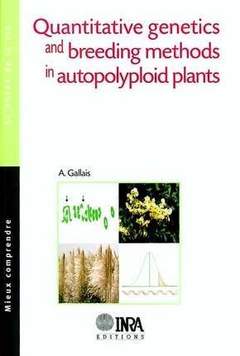Quantitative genetics and breeding methods in autopolyploid plants Mieux comprendre - Sciences de la vie Series
Langue : Anglais
Auteur : Gallais André

Partant des particularités de l'état autopolyploïde, cet ouvrage est une formulation des concepts essentiels dans les domaines suivants : génétique des populations, génétique quantitative, méthodologie de sélection et création de variétés. De nombreux résultats sont aussi présentés en fonction du niveau de ploïdie, la diploïdie devenant alors un cas particulier. La détection de QTL et la sélection assistée par marqueurs sont également traitées. C'est un ouvrage pour tous les chercheurs travaillant sur les espèces autopolyploïdes, pour les enseignants et les étudiants qui désirent approfondir leurs connaissances en considérant le niveau de ploïdie. Les sélectionneurs trouveront aussi les éléments pour choisir les méthodes de sélection et de création variétale les plus appropriées.
Preface - Notations of the main parameters - Main particularities of autopolyploids as compared wilh diploids - CHAPTER 1. Some General aspects of autopolyploid genetics - 1. Types and occurrence of polyploids - 2. Meiosis in autopolyploids - 3. The production of unreduced gametes in diploids - 4. Segregation for two loci - 5. Mapping in autopolyploids - PART I. POPULATION GENETICS - CHAPTER 2. Large Random Mating Populations - 1. Genetic constitution of a random mating population - 2. Changes of gene frequency due to mutation and selection - 2.1. Mutation and migratio - CHAPTER 3. Kinship, inbreding and small populations - 1. Kinship coefficients and coefficients of inbreeding - 2. Inbreeding in large populations 3. Finite and structured populations - 4. Natural selection in inbreeding populations - PART II. QUANTITATIVE GENETICS - CHAPTER 4. Genetic effects and quantitative genetics in random mating populations - 1. Genetic effects in random mating populations - 2. Covariance between relatives in panmictic populations - 3. Means and variances in non-equilibrium populations - 4. Mating designs to estimate variance components in random mating populations - 5. QTL detection in autotraploids - CHAPTER 5. Quantitative Genetics of inbred Populations - 1. Means of inbred populations - 2. Covariances among inbred relatives - 3. Effect of random mating after inbreeding - 4. Heterosis between two populations - PART III. POPULATION IMPROVEMENT AND VARIETAL DEVELOPMENT - CHAPTER 6. Population Improvement - 1. Principles and theory of recurrent selection - 2. Within population recurrent selection schemes - 3. Interpopulation recurrent selection- 4. Marker-assisted recurrent selection5. Some aspects of optimization of recurrent selection - CHAPTER 7. Varietal Development - . Development of clones varieties - 2. Line Development - 3. Hybrid development - 4. Development of synthetics - 5. Choice of type of varieties - By way of conclusion - On the usefulness of models in quantitative genetics and plant breeding - Appendices - Critical values of F distribution - Critical value of the Pearson correlation coefficient - Relationship between selection intensity (i) and percentage of selected units (p. %) - References - Author index - Subject index
Date de parution : 02-2004
Ouvrage de 516 p.
15.9x24 cm
Thème de Quantitative genetics and breeding methods in... :
© 2024 LAVOISIER S.A.S.
